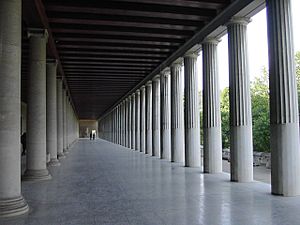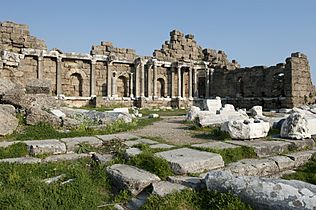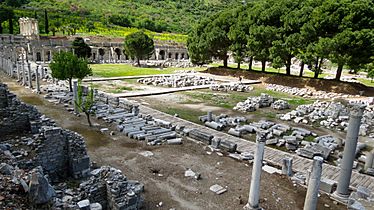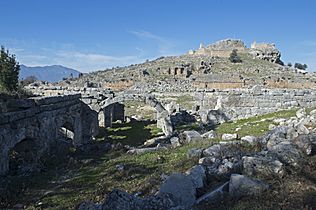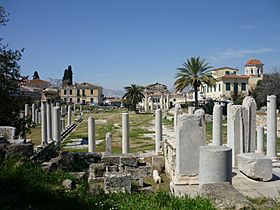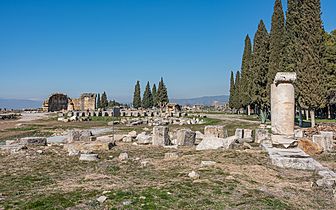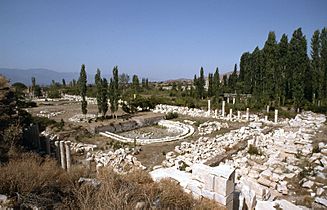Agora facts for kids

The agora (pronounced AG-uh-ruh) was a very important public space in ancient Greek city-states. A polis was like a city-state. The word "agora" means "gathering place" or "assembly." It was the heart of the city! People came to the agora for sports, art, business, social events, religious activities, and politics. The Ancient Agora of Athens is the most famous example of an agora.
Contents
What Was the Agora?
Where Did the Agora Come From?
Long ago in Greek history, from about 1300 BC to 400 BC, free citizens would meet in the agora. They gathered there for military duties or to hear important news from their king or leaders.
Later, the agora also became a busy marketplace. Merchants set up stalls or shops to sell their goods. These shops were often found under arcades, which are rows of arches. This made the agora a popular spot for artisans, who built their workshops nearby.
Because of these two main uses – a place for public speaking and a place for shopping – two Greek words came from "agora." The word agorázō meant "I shop," and agoreúō meant "I speak in public."
The Famous Agora of Athens
The Ancient Agora of Athens was located right below the northern side of the Acropolis. It was the main meeting spot for people in Athens. Here, citizens gathered to discuss important government matters. They also did business, hung out with friends, watched performers, and listened to famous philosophers share their ideas.
Religion was very important in the Athenian agora. It was a sacred place, and its holy feeling was even part of how the buildings were designed. The agora was built around the Panathenaic Way. This was a special road that went through the middle of Athens and led to the city's main gate, called Dipylon.
The Panathenaic Way was considered very sacred. It was used for the Panathenaic festival, a big event held every four years to honor the goddess Athena. The agora was also famous for having the Temple of Hephaestus. Hephaestus was the Greek god of metalworking and craftsmen. This temple is still in great condition today! Other temples that once stood in the agora honored gods like Zeus, Athena, Apollo, and Ares.
What Was the Agora Like?
Agoras were usually built in the center of a city or close to a harbor. They often featured colonnades, which are long rows of columns. They also had stoae, which were long, open walkways found under the colonnades. These areas were often decorated with beautiful fountains, trees, and statues.
When the Athenian agora was rebuilt after the Greco-Persian Wars, they didn't include colonnades and stoae at first.
What is Agoraphobia?
The word agoraphobia describes a type of fear. Someone with agoraphobia feels very anxious in new or unfamiliar places. This can happen in wide-open spaces, in crowds, or in public situations where they feel they have little control. The word "agoraphobia" comes from the agora, because it was a large, open gathering place.
Gallery
-
The Agora of Ephesus
-
The Agora of the Competaliasts on Delos, Greece
-
The Roman Agora (Delphi), Greece
See also
 In Spanish: Ágora para niños
In Spanish: Ágora para niños
- Forum (Roman)
- Agorism
- Platonic Academy
- Egora (electronic agora)


